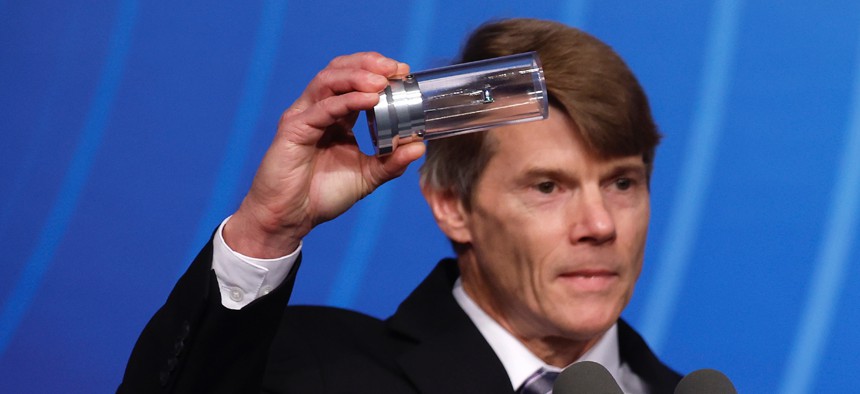Lawrence Livermore researchers achieve fusion ignition for a second time

Marvin Adams, NNSA deputy administrator for Defense Programs, holds up a cylinder he says is similar to one used by the Lawrence Livermore National Laboratory for a breakthrough in fusion research in December 2022. Researchers at the laboratory said they repeated the fusion results in July. Chip Somodevilla / Getty Images
After a groundbreaking success in generating fusion ignition in December 2022, researchers repeated the victory in late July and will publish results soon.
Researchers at Lawrence Livermore National Laboratory successfully generated fusion ignition again following the lab’s groundbreaking experiment conducted in December 2022.
Michael Padilla, the media relations deputy director at Lawrence Livermore, confirmed to Nextgov/FCW that during an experiment conducted on July 30, scientists were able to generate fusion ignition for a second time.
“Analysis of those results is underway,” he said. “As is our standard practice, we plan on reporting those results at upcoming scientific conferences and in peer-reviewed publications.”
Compared to nuclear fission — which splits atoms to produce energy and is the method employed by nuclear power plants today — fusion combines two atoms to create energy without the radioactive byproducts produced by fission.
The latest experiment was run at the laboratory’s National Ignition Facility Laser and Target Area Building.
Following last year’s triumphant fusion energy experiment conducted by Lawrence Livermore, federal agencies and lawmakers alike have paid close attention to the growth of fusion technology in the U.S.
Last week, the Department of Energy announced three sets of fusion energy research and development grants within the agency’s ARPA-E office, with funds totalling around $9 million for 18 different projects.
“The projects announced today are outside-the-box ideas, and present a variety of exciting ways to identify solutions and reach President Biden’s ambitious decarbonization goals,” said ARPA-E Director Evelyn Wang in a press release on the grants. “These teams — representing American businesses, laboratories and universities — understand that reaching our nation’s goals requires an all-hands-on-deck approach with all ideas on the table.”
Rep. Zoe Lofgren, D-Calif., released a statement of support following Energy’s announcement.
“It’s an exciting time for fusion energy development,” said Lofgren, whose district encompasses U.S. tech haven Silicon Valley and is near the San Francisco Bay Area. “After the breakthrough achievement of fusion ignition at the National Ignition Facility at LLNL last year, I’m happy to see the Biden administration doubling down with investments in this critical technology. And I’m very excited to see so many Bay Area groups leading in this effort. These investments are good for California and vital to securing our clean energy future.”



